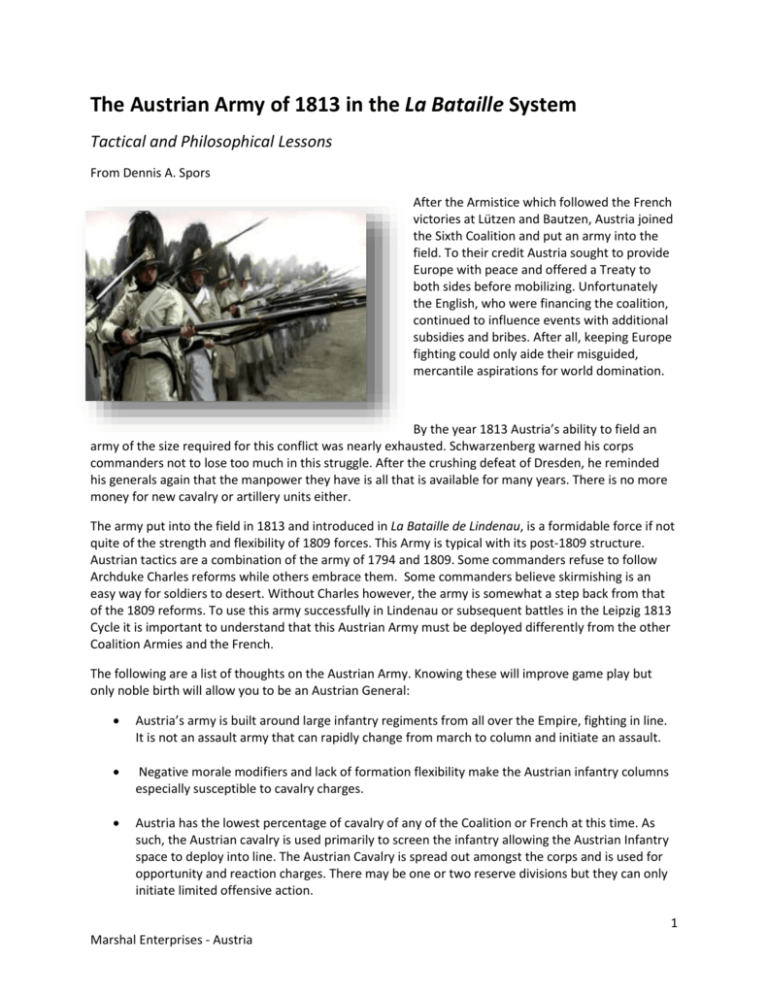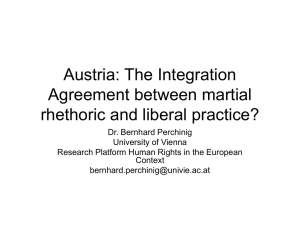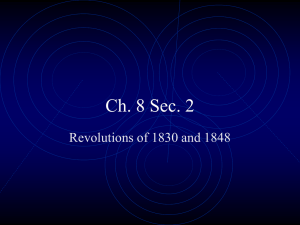The Austrian Army
advertisement

The Austrian Army of 1813 in the La Bataille System Tactical and Philosophical Lessons From Dennis A. Spors After the Armistice which followed the French victories at Lützen and Bautzen, Austria joined the Sixth Coalition and put an army into the field. To their credit Austria sought to provide Europe with peace and offered a Treaty to both sides before mobilizing. Unfortunately the English, who were financing the coalition, continued to influence events with additional subsidies and bribes. After all, keeping Europe fighting could only aide their misguided, mercantile aspirations for world domination. By the year 1813 Austria’s ability to field an army of the size required for this conflict was nearly exhausted. Schwarzenberg warned his corps commanders not to lose too much in this struggle. After the crushing defeat of Dresden, he reminded his generals again that the manpower they have is all that is available for many years. There is no more money for new cavalry or artillery units either. The army put into the field in 1813 and introduced in La Bataille de Lindenau, is a formidable force if not quite of the strength and flexibility of 1809 forces. This Army is typical with its post-1809 structure. Austrian tactics are a combination of the army of 1794 and 1809. Some commanders refuse to follow Archduke Charles reforms while others embrace them. Some commanders believe skirmishing is an easy way for soldiers to desert. Without Charles however, the army is somewhat a step back from that of the 1809 reforms. To use this army successfully in Lindenau or subsequent battles in the Leipzig 1813 Cycle it is important to understand that this Austrian Army must be deployed differently from the other Coalition Armies and the French. The following are a list of thoughts on the Austrian Army. Knowing these will improve game play but only noble birth will allow you to be an Austrian General: Austria’s army is built around large infantry regiments from all over the Empire, fighting in line. It is not an assault army that can rapidly change from march to column and initiate an assault. Negative morale modifiers and lack of formation flexibility make the Austrian infantry columns especially susceptible to cavalry charges. Austria has the lowest percentage of cavalry of any of the Coalition or French at this time. As such, the Austrian cavalry is used primarily to screen the infantry allowing the Austrian Infantry space to deploy into line. The Austrian Cavalry is spread out amongst the corps and is used for opportunity and reaction charges. There may be one or two reserve divisions but they can only initiate limited offensive action. 1 Marshal Enterprises - Austria Artillery is used to directly support infantry battalions and regiments in line formations. Rather than as a reserve pounding a target, the Austrian Artillery adds fire power to the infantry lines When the Austrians have little or no cavalry and the immediate enemy does, the Austrian infantry chooses to advance in Divisional Masse. Although having a little better fire defense than a square the movement allowance is very good. The Divisional Masse has a good defense from cavalry melee and decent defensive fire. This formation has no zone of influence however and cavalry may ride through taking defensive fire. Battalions in Division Masse can form a wall in front of an advancing Corps with columns and artillery behind. Divisional Masse is not an attack formation. Another formation used by the Austrian Infantry to protect itself against enemy cavalry is the Battalion Masse. This is easy for the Austrian Infantry to form as they just need to close-up the distance between ranks. Mobility is somewhat limited and the density of the formation makes it a target. However you can close to and engage an enemy, fight through enemy cavalry screen and enterer a zone d’ influence. Use the assault formation where the enemy infantry is reduced in numbers and fighting spirit. Austrian Jägers and Grenz troops are excellent skirmishers but there are too few of them and they are usually in the Advance Division of each Corps. Advance Divisions also have light cavalry. The skirmishers and cavalry in skirmish order form a screen for an advancing Infantry division. Leave 5 or 6 hexes from the enemy to deploy from column to line. Unlimber the artillery and place it in the line hexes. Once supported, move forward a hex at a time. The Austrian formations are deadly in a straight fire fight where maneuver is not an issue. Back your lines with battalions in Battalion Masse. In this way if the front line collapses, there is something to stop the enemy charge. Battalion Masse has more movement than a square. Form square in your turn and not when charged by enemy cavalry. Notice a square can only be formed from line. The Austrian Army was excellent on the drill field but not flexible enough on the battlefield. Commit Austrian Troops by the Division or wing. This is the way they are measured for Morale Levels. If a division goes on Level One, pull the division back and let it recover. Because the Morale is measured by the division it takes far less battalions routing or eliminated for an Austrian Division to go on level one. It may be only a few unlucky die rolls. Then a large part of the Corps is immediately ineffective. If you don’t pull this division out of combat it will rapidly go to Level Two or Level Three. Austrian Divisions don’t come back from Level Three. The Austrian Army is not a weapon for mobile offensive or to engage until the Divisions are fully deployed. Be methodical and not audacious. Keep the Combat a la Fue chart in your left hand and the dice in your right. The Austrian should not be reaching for the Combat a Melee chart very often. 2 Marshal Enterprises - Austria Austria does not have a guard formation. Many of the Grenadier companies are formed into battalions and these, make-up a division. The Grenadiers will stand, fire and melee well if supported. The Austrians are one of the few armies that tactically “dig” into towns. They will barricade the streets and loophole the houses. Perhaps the lack of friendly cavalry compels them to stay in built-up areas. Leadership is not a strong element of the Austrian Army. Some leaders may gather troops to reform but the feudalist structure of the state does not inspire the sacrifices by the ordinary Polish or Moravian Soldier. He is forced to wage war for a German monarchy that considers him property and a church that imposes self-serving medieval dogma, rather than a citizen of a free Republic. o "Faith is beyond the reach of the law. It is the most personal possession of man, and no one has the right to demand and account for it." Napoleon I 3 Marshal Enterprises - Austria Review this table for the various formations and their characteristics. Austria Formation Column Line Divisional Masse Battalion Masse Square Road March General Order Disorder Rout Line Infantry Modifiers To Morale -3 Printed Printed 3 6 -12 Terrain -3 -6 To Movement Cav. Charge Fire Defense Fire Zone d’ Inf. Melee Printed -3 +1 -2 1 x2 Terrain NA 10R See Chart Adds 3 Adds 2 Adds 3 Adds 6 Chart plus NA Chart plus Increm. Loss 6 9 6 5 4 4 Terrain 14 14 Printed x2* Printed Printed x2* NA Printed x.5* NA Yes Yes No Yes No Yes Yes No No Printed Printed NA / Print. Printed NA X.25 Printed X.5 NA /X.33 *All fire values should be checked in the special rules and avoid Napoleon 4 Marshal Enterprises - Austria





